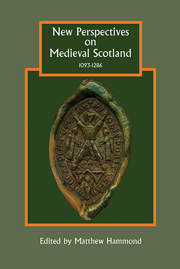Book contents
- Frontmatter
- Contents
- List of illustrations and tables
- List of contributors
- Acknowledgements
- Abbreviations
- Maps
- 1 Introduction: The paradox of medieval Scotland, 1093–1286
- 2 The Scottish ‘political community’ in the reign of Alexander II (1214–49)
- 3 Homo ligius and unfreedom in medieval Scotland
- 4 Scottish royal government in the thirteenth century from an English perspective
- 5 Neighbours, the neighbourhood, and the visnet in Scotland, 1125–1300
- 6 Cistercian identities in twelfth- and thirteenth-century Scotland: the case of Melrose Abbey
- 7 The language of objects: material culture in medieval Scotland
- 8 Structuring that which cannot be structured: a role for formal models in representing aspects of medieval Scotland
- Bibliography
- Index
- STUDIES IN CELTIC HISTORY
6 - Cistercian identities in twelfth- and thirteenth-century Scotland: the case of Melrose Abbey
Published online by Cambridge University Press: 05 August 2013
- Frontmatter
- Contents
- List of illustrations and tables
- List of contributors
- Acknowledgements
- Abbreviations
- Maps
- 1 Introduction: The paradox of medieval Scotland, 1093–1286
- 2 The Scottish ‘political community’ in the reign of Alexander II (1214–49)
- 3 Homo ligius and unfreedom in medieval Scotland
- 4 Scottish royal government in the thirteenth century from an English perspective
- 5 Neighbours, the neighbourhood, and the visnet in Scotland, 1125–1300
- 6 Cistercian identities in twelfth- and thirteenth-century Scotland: the case of Melrose Abbey
- 7 The language of objects: material culture in medieval Scotland
- 8 Structuring that which cannot be structured: a role for formal models in representing aspects of medieval Scotland
- Bibliography
- Index
- STUDIES IN CELTIC HISTORY
Summary
The concept of ‘Cistercianness’, Cistercian ethos or ideal, has a long history, and on the whole has been understood as something that developed fairly early on, in the first decades of the twelfth century, and then continued to shape monastic history for the rest of the middle ages. Therefore, any deviation from it has been seen as a symptom of decline and diversion from a correct path. The editions of key early Cistercian sources by Chrysogonus Waddell changed the chronology of many of these texts and made clear that they, and hence the ideas contained in them, developed over several decades. A very radical, and much contested, interpretation by Constance Berman postulated that the structures of the order did not come into being until the 1160s at the earliest and were preceded by a slow transformation of the amorphous ‘Cistercian movement’. These debates helped to abandon finally the idea that ‘true’ Cistercian spirit and identity as set in the early twelfth century was to define the monastic experience for the rest of the middle ages and any deviation from this rigid set of ideas indicated ‘decline’. Moreover, the extensive geographical expansion of the Cistercian family in the twelfth century also poses the question of the nature of ‘Cistercianness’ beyond its French core. Were Cistercian abbeys in Scotland, Ireland, Scandinavia, or beyond the River Elbe the same in their practice, outlook, and self-identification as monasteries in Burgundy, Italy, or England? It is too simplistic to describe them simply as somehow less Cistercian than their mother houses.
- Type
- Chapter
- Information
- New Perspectives on Medieval Scotland, 1093-1286 , pp. 175 - 182Publisher: Boydell & BrewerPrint publication year: 2013



